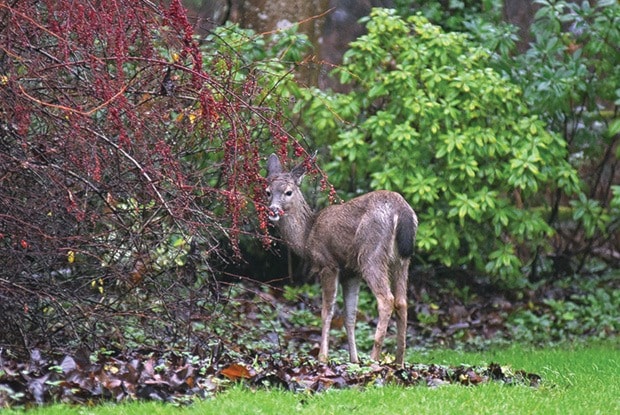Oak Bay and the Capital Regional District announced Tuesday that the population reduction component of the Deer Management Strategy pilot project was complete.
Mayor Nils Jensen called the 16-day cull a success, with 11 deer removed as part of the CRD deer management strategy.
“This is a pilot project. It was more about learning whether this could be done in an urban environment and in a mild temperate climate and how it could be done under those circumstances,” said Jensen. “It wasn’t about fixing a problem with a one-time cull.”
The Ministry of Forest Lands and Natural Resource Operations issued Oak Bay a permit to cull up to 25 black-tailed deer. The contractor, Kootenay resident Ron Kerr, whose previous experience includes several population reduction programs in Cranbrook and Kimberley, was trained by provincial wildlife staff in capture and euthanization procedure. Modified clover traps were active on private properties – seven bucks and four does were captured and killed.
The B.C. SPCA, which started voicing concern in 2013 over the cull and continued to share concerns publicly, said the results don’t meet the definition of success.
“To say it’s a success is really misleading. You’re not addressing solutions that you claim to have with urban deer conflicts,” said Sara Dubois, chief scientific officer for B.C. SPCA. “If they were concerned about overpopulation you worry about females. If you are concerned about vehicle areas, you trap around roads. … They have no measures beyond political points here.”
B.C. SPCA along with organizations such as DeerSafe Victoria opposed the cull, citing other portions of the deer management plan that they felt hadn’t been addressed. Those include speed reduction, public education and a proper deer count.
“We don’t know what the population is,” Dubois said. “From a scientific perspective, no answers have been achieved from these actions.”
The purpose of the pilot project in Oak Bay was to reduce incidents of deer/human conflict and as the first in an urban neighbourhood, information was gleaned, Jensen said.
“We were, of course, concerned about vandalism and criminal activity which was seen in Kimberley and Cranbrook areas, we were able to show it can be conducted without that,” Jensen said.
While the permit allowed Oak Bay to continue the cull up to 25 deer until March 15, Kerr was unavailable.
“We could have found someone perhaps locally but it wouldn’t been a training issue and an experience issue,” Jensen said.
Lessons learned listed in a press release from Oak Bay: early spring offered an abundance of food which deterred some deer from entering the baited traps. Raccoons and rats triggered the traps on a regular basis and caused damage that required repairs.
Despite being the only current permitted population reduction methodology available in B.C., residents continue to oppose culling deer. There is a need for increased co-ordination and collaboration between the province and local governments to ensure consistent, accessible and effective communication with the public to support responsible urban deer management.
The deer management strategy, including the cull portion, will be reviewed and a formal report will be presented to the CRD’s planning, transportation and protective services committee and Oak Bay council.
cvanreeuwyk@oakbaynews.com
